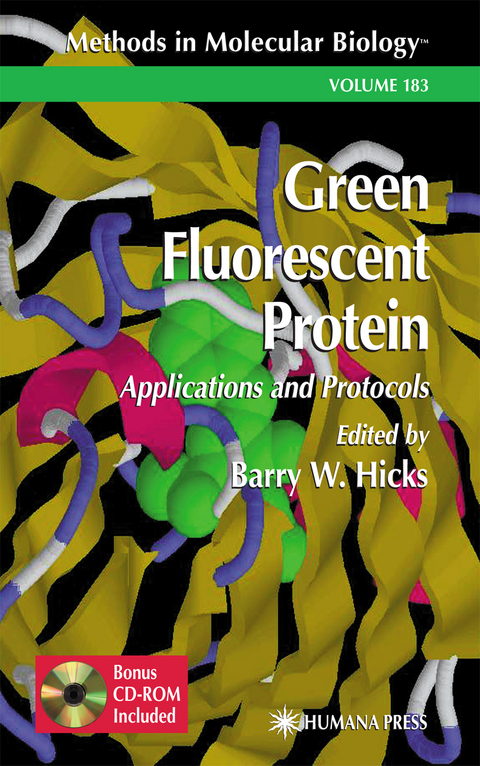
Green Fluorescent Protein
Humana Press Inc. (Verlag)
978-0-89603-905-6 (ISBN)
Manipulation of Green Fluorescent Protein Structure at the Genetic Level.- Amplification of Representative cDNA Samples from Microscopic Amounts of Invertebrate Tissue to Search for New Genes.- Use of cobA and cysGA as Red Fluorescent Indicators.- Circular Permutation of the Green Fluorescent Protein.- Evolutionary Design of Generic Green Fluorescent Protein Biosensors.- Random Insertion of Green Fluorescent Protein into the Regulatory Subunit of Cyclic Adenosine Monophosphate-Dependent Protein Kinase.- Circular mRNA Encoding for Monomeric and Polymeric Green Fluorescent Protein.- Detection and Imaging of Green Fluorescent Protein.- Fluorescence Lifetime Imaging (FLlM) of Green Fluorescent Fusion Proteins in Living Cells.- 8 Fluorescence Resonance Energy Transfer (FRET) Applications Using Green Fluorescent Protein.- Bioluminescence Resonance Energy Transfer Assays for Protein-Protein Interactions in Living Cells.- Whole-Body Fluorescence Imaging with Green Fluorescence Protein.- Green Fluorescent Protein to Monitor Protein Distribution and Trafficking.- Drug-Induced Translocation of Nucleolar Proteins Fused to Green Fluorescent Protein.- Light-Induced Nuclear Targeting of PhytochromeB-sGreen Fluorescent Protein in Plants.- Mechanisms of Protein Trafficking.- Analysis of Nucleocytoplasmic Transport Using Green Fluorescent Protein.- Green Fluorescent Protein in Transgenic Organisms.- Transgenic Bovine Embryo Selection Using Green Fluorescent Protein.- Development of Glycosylphosphatidylinositol-Anchored Enhanced Green Fluorescent Protein.- Transgenic Zebrafish Expressing Green Fluorescent Protein.- Transgenic Insects Expressing Green Fluorescent Protein-Silk Fibroin Light Chain Fusion Protein in Transgenic Silkworms.- Green Fluorescent Protein inTransgenic Plants.- GreenFluorescent Protein Biosensors.- Green Fluorescent Protein Calcium Biosensors.- Green Fluorescent Protein Fluobody Immunosensors.- 22 Green Fluorescent Protein-Based Protein Kinase Biosensor Substrates.- Green Fluorescent Protein Urea Sensors.- Viral Applications of Green Fluorescent Protein.- Using Green Fluorescent Protein to Monitor Measles Virus Cell-to-Cell Spread by Time-Lapse Confocal Microscopy.- Tracking and Selection of Retrovirally Transduced Murine Bone Marrow Cells Using Green Fluorescent Protein.- Green Fluorescent Protein as a Reporter of Adenovirus-Mediated Gene Transfer and Expression in the Hypothalamic-Neurohypophyseal System.- Enhancement of Green Fluorescent Protein Expression in Adeno-Associated Virus with the Woodchuck Hepatitis Virus Post-Transcriptional Regulatory Element.- Construction of Infectious Simian Varicella Virus Expressing Green Fluorescent Protein.- Green Fluorescent Protein in Retroviral Vector Constructs as Marker and Reporter of Gene Expression for Cell and Gene Therapy Applications.
| Erscheint lt. Verlag | 20.6.2002 |
|---|---|
| Reihe/Serie | Methods in Molecular Biology ; 183 |
| Zusatzinfo | XIV, 394 p. |
| Verlagsort | Totowa, NJ |
| Sprache | englisch |
| Maße | 155 x 235 mm |
| Themenwelt | Naturwissenschaften ► Biologie ► Genetik / Molekularbiologie |
| Naturwissenschaften ► Biologie ► Mikrobiologie / Immunologie | |
| Naturwissenschaften ► Biologie ► Zellbiologie | |
| ISBN-10 | 0-89603-905-6 / 0896039056 |
| ISBN-13 | 978-0-89603-905-6 / 9780896039056 |
| Zustand | Neuware |
| Haben Sie eine Frage zum Produkt? |
aus dem Bereich


